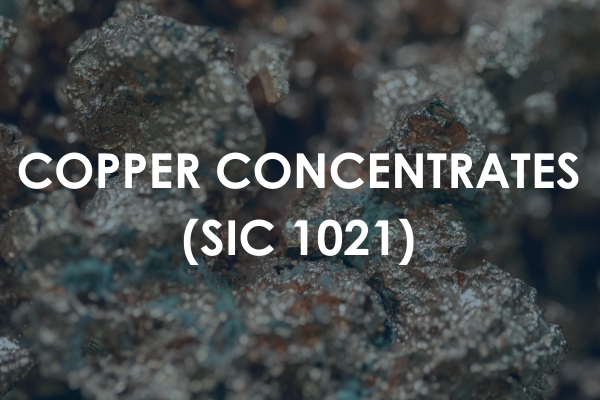- Topics
- Themes
-
Trade
Do you want to know how access to trade finance can increase your cross-border imports and exports? Explore our Trade Finance hub for practical tools.
Treasury
Are you a treasury or operations manager looking to mitigate the risks and efficiently manage your business’ cash flow? If so, check out our Treasury Management hub.
Payments
Whether you want updates from infrastructure support to cross-border transactions or clearing house operations to processing techniques, you can find all on our Payments hub.
Letters of Credit
Ready to to increase your imports / exports to guarantee the payment and delivery of goods? Find out more about LCs here.
Shipping & Logistics
Whether you’re transporting goods, or learning about supply chains, warehousing, transportation and packaging, we’ve got you covered.
Incoterms
Need to know which International Commerce Term is right for your needs? Explore our curated guides from shipping expert Bob Ronai.
Sustainability
Prioritising sustainable supply chains? Building inclusive trade? Working towards the UN’s 2030 SDGs? Read the latest on global sustainable standards vs green-washing here.
Customs
Heading into international markets? From the correct documentation to standardisation, here’s what you need to know for a streamlined customs clearance process.
TradeTech
TradeTech is rapidly evolving to help reduce some of the biggest challenges when it comes to trade. Keep up with these innovations here.
-
- News & Insights
-
News
The latest in Trade, Treasury & Payments - stay up to date on all the changes across the globe.
Magazines
The issues feature experts across the industry on the latest developments with specific themed and regional editions.
Articles
Insights by the industry, for the industry. These include thought leadership pieces, interview write ups and Q&As.
Guides
Working closely with industry experts and trade practitioners we provide inclusive educational guides to improve your technical knowledge and expertise in global trade.
Research & Data
We undertake qualitative and quantitative research across various verticals in trade, as well as create reports with industry association partners to provide in-depth analysis.
Trade Finance Talks
Subscribe to our market-leading updates on trade, treasury & payments. Join the TFG community of 160k+ monthly readers for unrivalled access in your inbox.
-
- Media
- Events
-
Partner Conferences
We partner with industry conferences around the world to ensure that you don’t miss out on any event; in person or online, add to your calendar now.
Women in Trade, Treasury & Payments
Get involved in our most important campaign of the year, celebrating the achievements of women in our industry and promoting gender equity and equality.
Awards
Our excellence awards in trade, treasury, and payments are like no other. You can't sponsor them, and they're independently judged. They are the most sought-after industry accolades.
Online Events
Join our virtual webinars and community events. Catch up on-demand, right here on TFG.
-
- Editions
- Themes
- Access Finance
- Finance Products
-
Trade Finance
Trade finance is a tool that can be used to unlock capital from a company’s existing stock, receivables, or purchase orders. Explore our hub for more.
Invoice Finance
A common form of business finance where funds are advanced against unpaid invoices prior to customer payment
Supply Chain Finance
Also known as SCF, this is a cash flow solution which helps businesses free up working capital trapped in global supply chains.
Bills of Lading
BoL, BL or B/L, is a legal document that provides multiple functions to make shipping more secure.
Letters of Credit
A payment instrument where the issuing bank guarantees payment to the seller on behalf of the buyer, provided the seller meets the specified terms and conditions.
Stock Finance
The release of working capital from stock, through lenders purchasing stock from a seller on behalf of the buyer.
Factoring
This allows a business to grow and unlock cash that is tied up in future income
Receivables Finance
A tool that businesses can use to free up working capital which is tied up in unpaid invoices.
Purchase Order Finance
This is commonly used for trading businesses that buy and sell; having suppliers and end buyers
-
- Sectors
-
Machinery & Equipment
Technology, construction, telecommunications, PPE, and electronics
Commodities & Materials
Raw materials, agricultural products, minerals, metals, and textiles
Chemical & Energy
Pharmaceuticals, chemicals, and energy products
Autos, Aerospace & Marine
Automotive, aviation, and marine industries
Pharma & Healthcare
Pharmaceuticals, healthcare equipment, and related sectors
Metals & Mining
Ores, minerals, metals, and concentrates
Finished Goods
Retail stock, e-commerce, textiles, clothing, and consumer goods
Construction & Projects
Construction, infrastructure, project finance, and green finance
Tech, Media & Telecom
Construction, infrastructure, project finance, and green finance
Food & Beverages
Food, drink, dairy, confectionery, and alcohol
Professional Services
E-commerce, recruitment, legal services, and hospitality
-
- Case Studies
-
Informing today's market
Financing tomorrow's trade
Soft Commodities Trader
Due to increased sales, a soft commodity trader required a receivables purchase facility for one of their large customers - purchased from Africa and sold to the US.
Metals Trader
Purchasing commodities from Africa, the US, and Europe and selling to Europe, a metals trader required a receivables finance facility for a book of their receivables/customers.
Energy Trading Group
An energy group, selling mainly into Europe, desired a receivables purchase facility to discount names, where they had increased sales and concentration.
Clothing company
Rather than waiting 90 days until payment was made, the company wanted to pay suppliers on the day that the title to goods transferred to them, meaning it could expand its range of suppliers and receive supplier discounts.
-
- Search
- Get Trade Finance
- Finance Products
- About Us
- Talk To Us
Copper Concentrates (SIC 1021)


Access trade, receivables and supply chain finance
We assist companies to access trade and receivables finance through our relationships with 270+ banks, funds and alternative finance houses.
Get startedContent
Copper concentrates: A comprehensive overview
Copper concentrates are an essential component in the mining industry. They act as a critical intermediary between the extraction of copper ore and its final refinement into usable copper products.
Copper concentrates are an essential component in the mining industry. They act as a critical intermediary between the extraction of copper ore and its final refinement into usable copper products.
They connect mining sites rich in copper ore to production facilities that refine the ore into pure copper, which is used across many industries.
As the demand for copper continues to rise due to its varied applications, the production and trading of copper concentrates have become crucial elements in international commerce.
Production and global leadership
Countries like Chile, Peru, and China lead the way in copper concentrate production thanks to their abundant copper ore deposits.
The production process begins with mining copper ores, which are then crushed and processed to extract copper in a concentrated form. This form typically contains about 20-30% copper and trace amounts of other valuable metals such as gold and silver.
This high concentration of copper makes the material valuable for further processing in smelting and refining operations.
Properties and composition
Copper concentrates are primarily valued for their copper content. However, the presence of gold and silver, even in minor amounts, can significantly increase their worth.
The quality and specific characteristics of copper concentrates can vary depending on the source ore and the extraction technique employed. This variance requires precise analysis and categorisation to ensure optimal processing in the next stages of metal production.
Uses and industrial applications
Copper concentrates are primarily used in the metallurgical processes of smelting and refining, where they are transformed into pure copper. This refined copper is then used in various manufacturing sectors.
For instance, copper’s excellent conductivity makes it indispensable for producing wires, circuit boards, and microchips in electronics.
Due to its durability and resistance to corrosion, copper is also used in roofing, plumbing, and electrical systems in construction.
Market dynamics
Several factors influence the market for copper concentrates:
- Supply and demand: The demand for copper concentrates is primarily driven by their use in the electronics, construction, and automotive industries. The growth in electric vehicle production and renewable energy projects amplifies this demand.
- Trade policies and geopolitical tensions: International trade regulations, tariffs, and political instability in major producing countries like Chile and Peru can significantly affect copper concentrates’ availability and cost. Such factors can disrupt supply chains and create market volatility, making the copper market particularly sensitive to changes in these regions’ political and economic landscape.
- Environmental regulations: Copper concentrate production is an energy-intensive process with considerable environmental impacts. Environmental regulations can increase production costs and limit output, directly impacting supply levels, copper prices, and market availability.
Price drivers
The global demand for copper influences pricing for copper concentrates, the availability of copper ore, smelting capacity, and environmental regulations.
These factors impact the price by affecting the supply chain efficiency or altering production costs.
Trade and finance
Copper concentrates are traded on the spot market, where transactions are made for immediate delivery at current prices, allowing for quick adaptation to market fluctuations.
They are also subject to forward and futures contracts, where prices are fixed for future delivery to hedge against price volatility.
Financial instruments such as letters of credit and supply chain finance are commonly used to manage the significant values involved in the copper concentrate trade.
Contract specifications
When traded, copper concentrates are priced in US dollars per metric ton and classified under specific Harmonised System (HS) codes to streamline international trade and customs processes.
These codes facilitate the efficient movement of goods across borders and ensure compliance with international trade laws.
Understanding the production processes, market dynamics, and trading practices associated with copper concentrates is essential for stakeholders to effectively navigate the complexities of this vital sector.
What is the SIC Code for Metals Concentrates?
SIC Code
1021
Copper Ore
More information about other metals concentrates
Case Study

TFG facilitated the financing of 100 metric tonnes of copper concentrates transported from a supplier in Chile to a customer in China through a sale and repurchase (repo) agreement. This financing arrangement allowed TFG to initially purchase the copper concentrates, providing the Chilean supplier with immediate liquidity. Subsequently, TFG sold the concentrates to the Chinese customer with an agreement to repurchase at a future date, giving the buyer the flexibility to manage their cash flow efficiently.






















